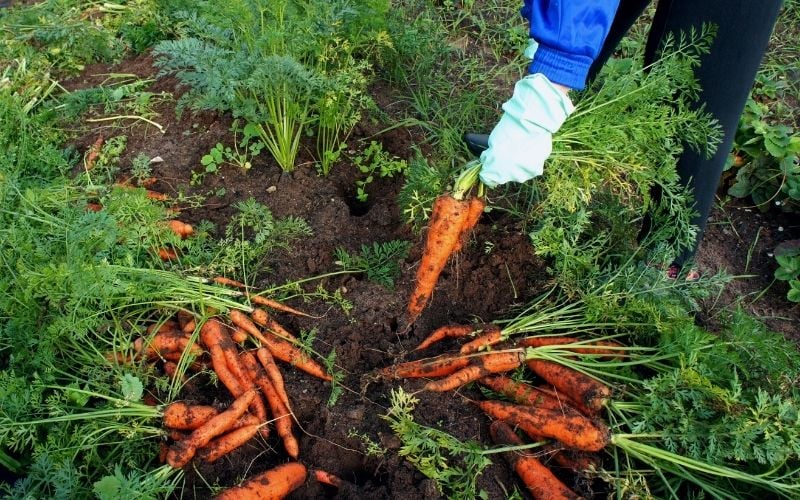
It is exciting to see your germinating carrots popping out of the ground and grow into healthy, bushy greens. But what is going on below the surface?
Carrots are easy to grow and can be harvested at any time during their cycle, but it’s important to know when they’re ready to be picked so that you don’t harvest too early or too late.
After months of dedicated weeding and tender care, it is very disappointing to pull up your carrots only to discover immature veggies that are tiny and taste like soap. It is even more disappointing to find the perfect carrot and break it off in the ground while you try to pull it out.
The best way to know when carrots are ready for picking is to wait and see. Yes, I’m being cheeky. But seriously, there’s no magic answer here. It can depend on the variety of carrot you’re growing as well as the soil conditions they’ve been grown in.
If you have never tried growing carrots before or don’t how to tell your carrots are ready to pull and how to harvest them, read on and you’ll be a pro at timing your carrot harvest!
How Long Does It Take To Grow A Carrot?
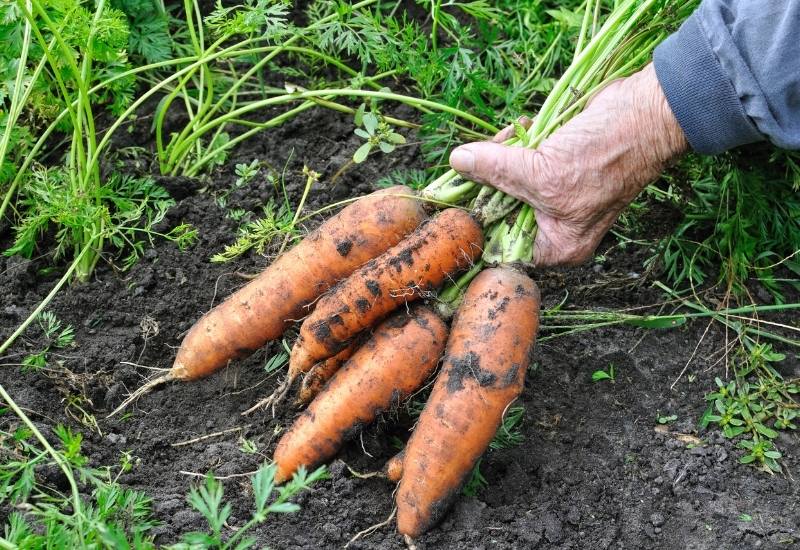
How long a carrot takes to grow depends on the variety. On average, the most commonly grown varieties in home gardens take about 70 days from germination to be ready to harvest.
Some carrots take as little as 50 days to mature while others may take 120 days to reach their full flavour and sweetness.
Check your seed packet for the “days to maturity” to know how long your carrots will take to grow.
How Do You Know When Your Carrots Are Ready To Harvest?
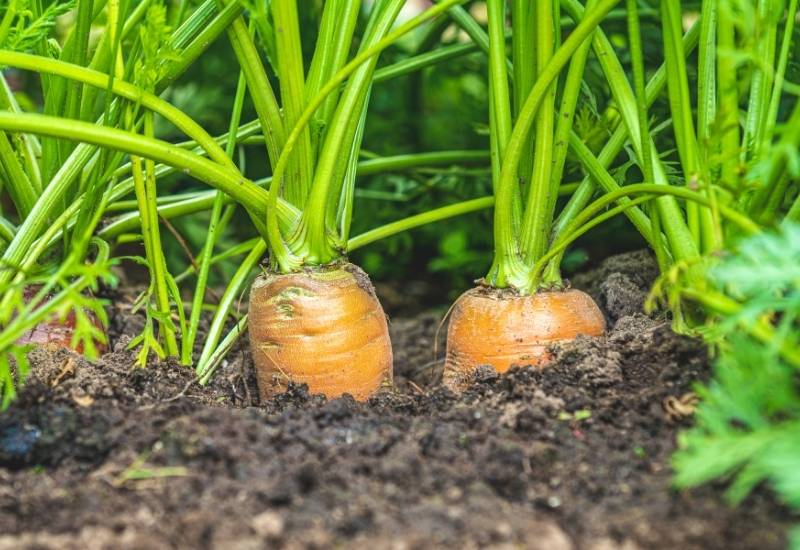
The days to maturity give you a good idea of when each variety is ready to harvest your carrots, but this only gives you a rough idea when the carrots will be ready in your own garden. Here are a few easy ways to tell if your carrots are ready to harvest:
1: Check The Carrot’s Color
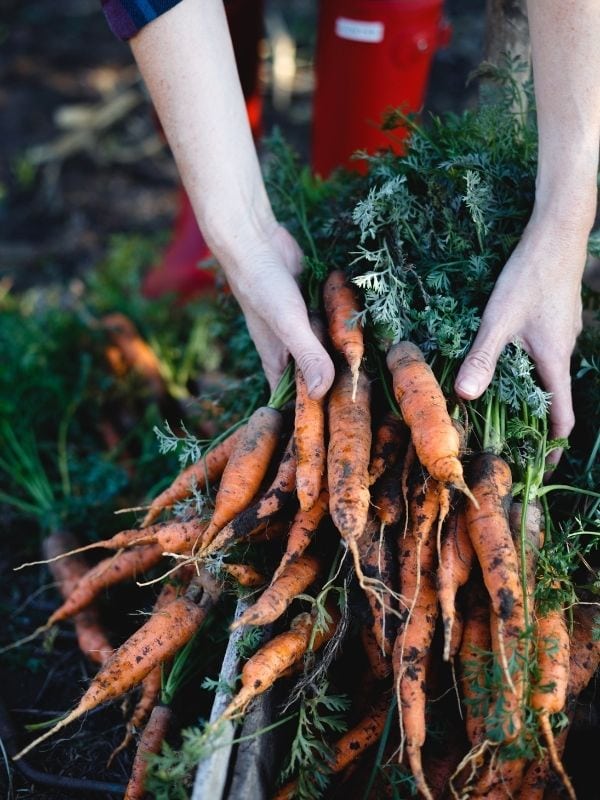
The best way to tell if your carrots are ready to harvest is to check the color of the carrots. A carrot is the sweetest and has the best flavor when it has reached its full color.
For most carrots, this will be bright orange but it can also be yellow, white, or purple depending on which variety you are growing.
2: Check The Size Of The Root
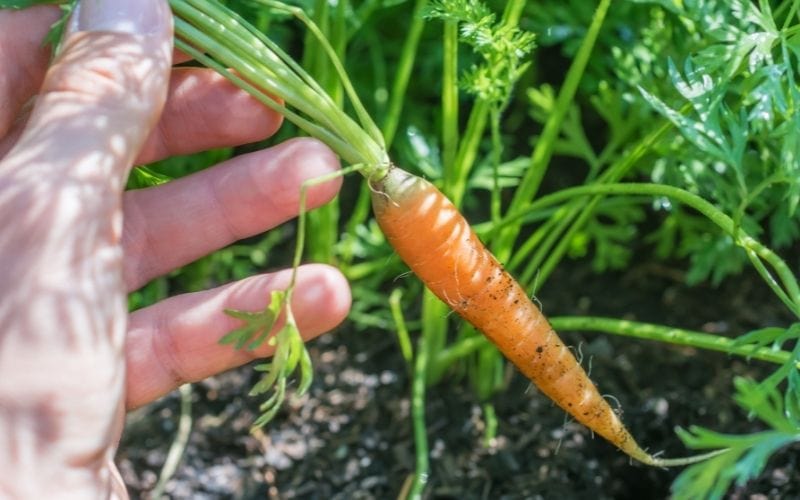
Another good indicator of carrot maturity is the size of the root, though the mature size greatly depends on the variety.
For commonly grown varieties, many gardeners like to wait until the top end of the carrot is about 1 cm (1/2 inch) in diameter.
This is usually quite easy to measure as the top of the carrot root, sometimes called the shoulder, will stick up above the soil.
If the carrot is buried under the soil you can dig down a little bit with your finger to expose the shoulder.
3: Have A Taste
The surest way to tell if your carrots have their best flavour is the taste test. Pull up one of your carrots and give it a taste to see if they are ready or if they need another week or two in the ground.
When Is the Right Time to Harvest Carrots Throughout The Year
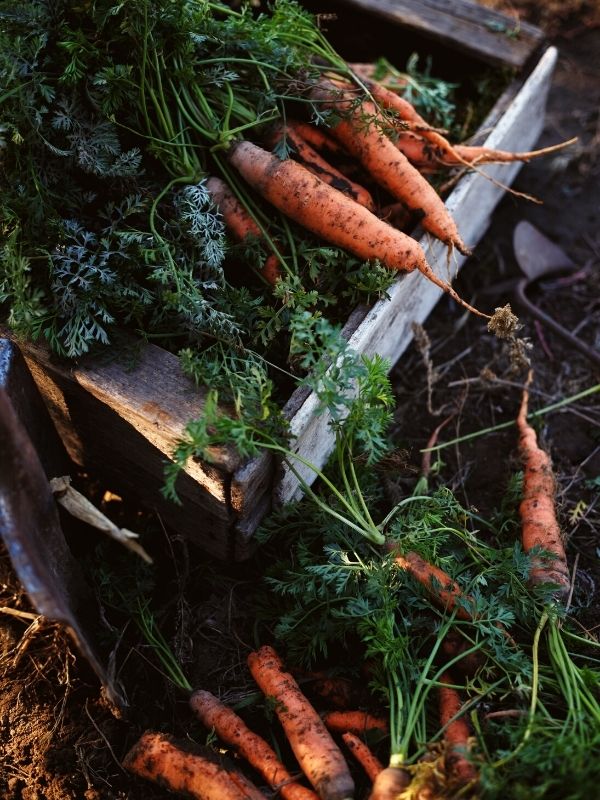
Even though carrots have their best flavour when they are mature and brightly coloured, they can be harvested throughout the year and still be sweet and delicious. Carrots are very cold hardy so you have several options when to start digging up your carrots.
1: Summer
When you plant your carrots in early spring, they will be ready to pick as baby carrots during the summer. Pick this delicious summer treat whenever your carrots are big enough to eat.
You can pick some of your carrots as baby carrots during the summer and then let the rest continue to grow into the fall. Be careful when pulling the baby carrots so as not to disturb the ones you are leaving. The same may apply if you succession plant, or grow cultivars with different maturity times.
2: Fall
Fall is generally the best time to harvest your carrots since the carrots won’t use up any sugar during the cool nights.
Your carrots will also get sweeter if you leave them in the garden until after a couple of frosts. In a process known as chill sweetening, the carrots convert starch stored in the root back into sugar to make the carrots extra sweet.
3: Winter
Since carrots are so cold-hardy (and keep getting sweeter as we just learned), they can often be left in the ground all winter long – just as long as the soil doesn’t freeze solid.
If your climate allows, this is a great way to store carrots, and you can simply dig a few carrots out of the garden any time you want a fresh meal during the winter. Many gardeners in colder climates will cover their carrots with straw for a bit of extra insulation.
If you do keep your carrots in the ground over winter, make sure to harvest them before the weather starts to warm in the spring.
As the weather turns warm, the carrot greens will start to grow again, stealing sugar from the root to start producing leaves and seeds. This is an easy way to save your own seeds, but the root will no longer be edible.
A Step-By-Step Guide To Harvesting Carrots
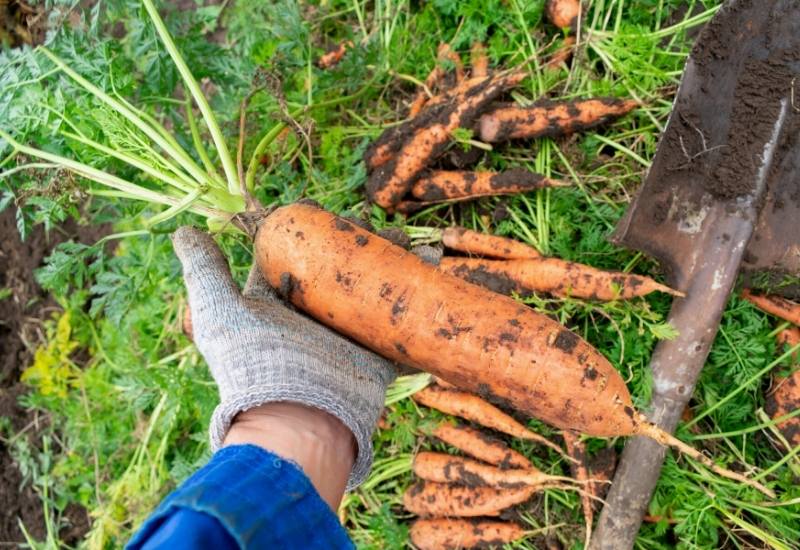
Once you know when you want to harvest your carrots, it is time to start digging. Harvesting carrots is really quite easy, but here are some helpful steps to make pulling your carrots go as smoothly as possible.
1: Check The Size
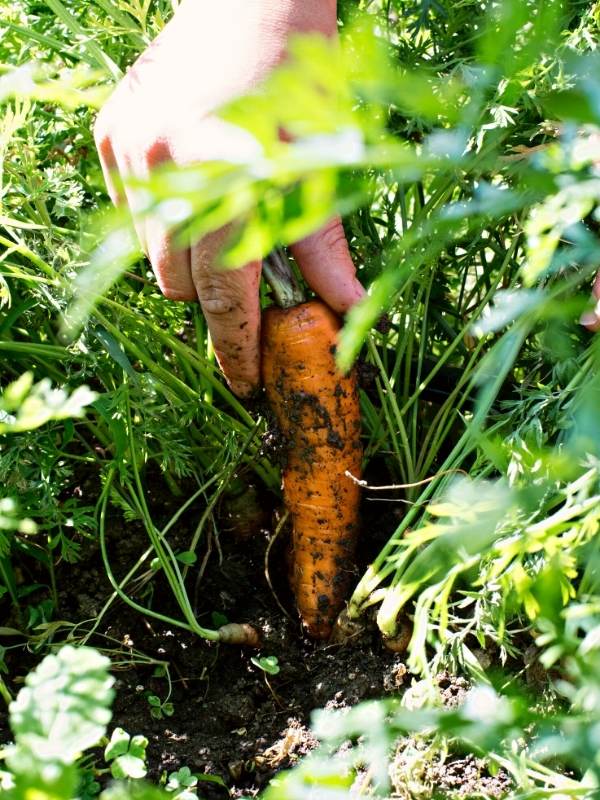
Make sure your carrots are ready by checking their color and size. Remember, just because the greens are huge doesn’t mean the carrot itself will be ready to harvest.
2: Water The Day Before
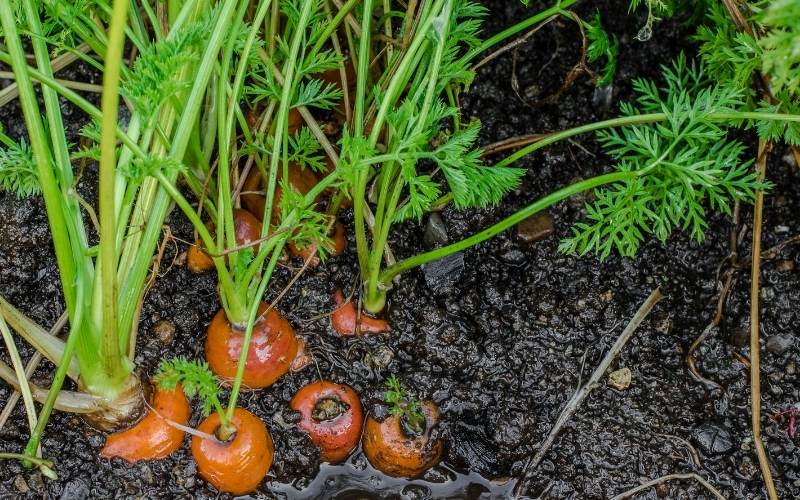
The day before you plan to harvest, it can be beneficial to lightly water your carrots. Alternatively, you can wait until the day after you had some rain. This will make sure that the roots are well hydrated before they are harvested.
However, too much water can be a pain, as it is difficult to harvest carrots in muddy soil. For an easy harvest, make sure the soil is moist but not overly wet.
3: Loosen The Soil
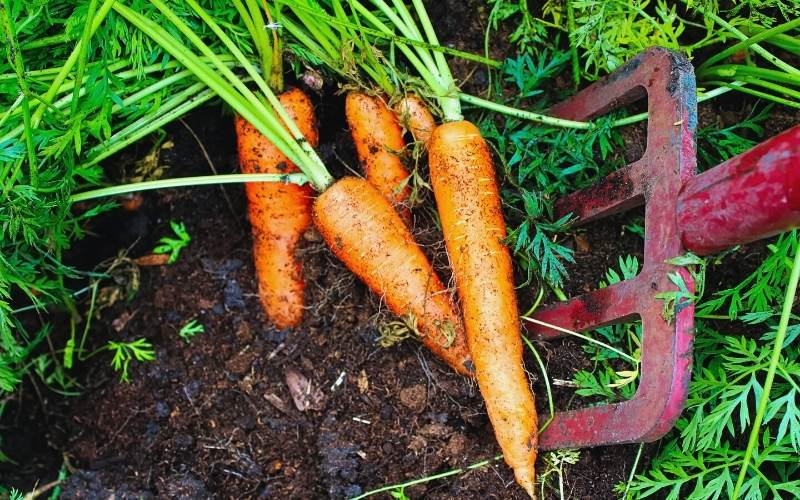
Have you ever had a carrot break off in the ground while you were trying to pull it? To alleviate this disappointing frustration, it is important to loosen the soil prior to pulling.
A garden fork is perfect for this step, but you can use a shovel or any other garden tool of your liking.
Stick your garden fork into the soil beside your carrots. Make sure you are far enough away so as not to spear and damage the roots. Then tip the fork backwards, away from your carrots, lifting the soil and carrots up.
4: Pull The Carrots
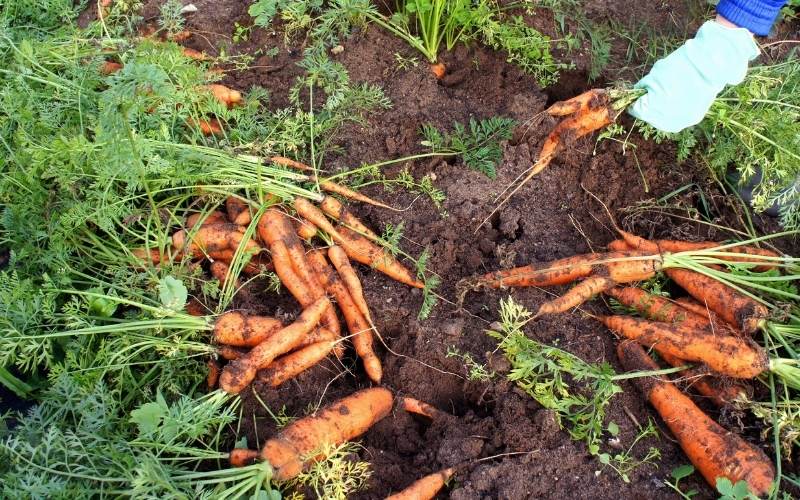
The soil should be loose enough that you can now pull your carrots with fear of them breaking. Grasp the carrots close to the base of the greens and give them a tug.
Most of the carrots should come right out, but you can loosen the soil a little more if they are still resisting.
5: Prepare For Storage
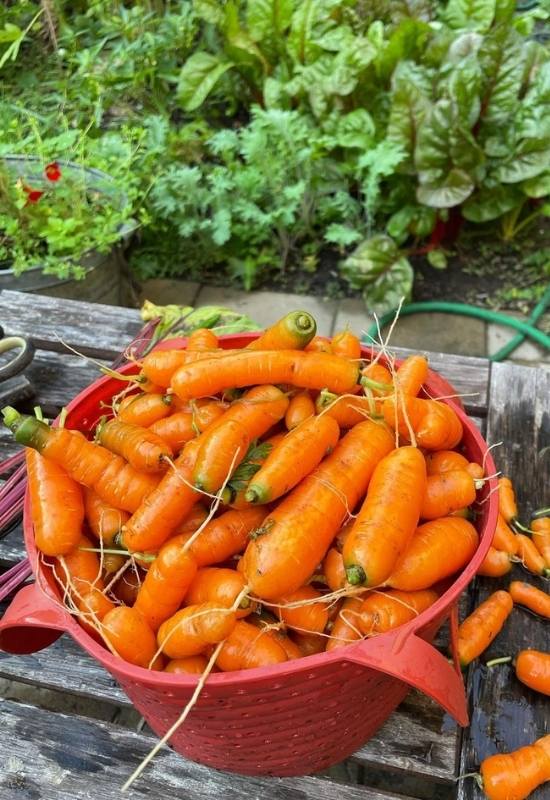
Brush off any extra dirt that slings to the carrot (at this point, you will be thankful the soil was not too wet). Unless you are eating them right away, do not wash your carrots.
Remove the greens by holding them tightly in your hand and twisting them off. It is best to remove the tops right at the top of the carrot, otherwise, any remaining green will quickly rot and spoil your harvest.
Leaving the tops attached will draw moisture and sugar out of the root, reducing the flavour, quality, and shelf life.
How To Store The Carrots You Just Picked From Your Garden
Store carrots right around the freezing mark, keeping them at 0°C (32°F) with 95% humidity.
Now that your crop is out of the ground, and if you don’t eat it all right away, it is time to pack your carrots away to store them for the winter. Here are some tips for good carrot storage.
For short-term storage, put the unwashed carrots in a Ziplock back and place them in your refrigerator. They will keep for about a month or two like this.
For long-term storage, they can be kept in a wood crate packed with moist sand where they should keep for 4 to 6 months. Carrots can also be canned, pickled, or frozen.
1: I picked some young carrots and they taste soapy. Why?
The answer is terpenoids. Terpenoids are responsible for the “carroty” flavour but they taste bitter and soapy on their own. Carrots produce terpenoids before they produce sugar so your carrots are probably underdeveloped.
2: Can you pick carrots too early?
Most people think that carrots are best picked when they’re big and fat, but in reality it’s better to pick them a little early. Many varieties are very delicious when picked as “baby carrots” and some of these can be picked after only a month or so.
If you pick a carrot very early and the terpenoids are too strong, the carrot is still edible even if the flavour is not yet at its peak.
3: What happens if you leave carrots in the ground too long?
After a few fall frosts, your carrots will actually get sweeter through a phenomenon known as chill sweetening, so it can sometimes be benficial to leave them in the ground a bit longer.
Some early developing varieties can become hairy and woody if left in the ground too long but they will still be edible. Carrots are biennial, so you can leave them in the ground over winter and they will flower the following year (though they are not very edible anymore).
4: Can you leave carrots in the ground over winter?
Many climates allow you to leave carrots in the ground all winter long, but make sure you harvest them if the ground is going to freeze solid or before they start to grow again in the spring.
I have eaten a few straw carrots in the spring that I had missed from the previous fall and they were still very tender and sweet. Make sure you plant them late enough so they do not become overmature before winter sets in.
5: Are cooked carrots sweeter?
Generally, yes. When you cook a carrot, the cell walls are broken down and trapped sugar is released. Cooking carrots can will also change other parts of the carrot.
Terpenoids, for example, are also modified when they are cooked which is why bitter carrots will often lose their bitterness after being cooked.

Written By
Amber Noyes
Amber Noyes was born and raised in a suburban California town, San Mateo. She holds a master’s degree in horticulture from the University of California as well as a BS in Biology from the University of San Francisco. With experience working on an organic farm, water conservation research, farmers’ markets, and plant nursery, she understands what makes plants thrive and how we can better understand the connection between microclimate and plant health. When she’s not on the land, Amber loves informing people of new ideas/things related to gardening, especially organic gardening, houseplants, and growing plants in a small space.

Thank you for this article. I am new to gardening and appreciate the time and effort you put in to write this.
I do have a question. I live where our fall-winter weather is mostly in the low 40’s and middle 30 degrees. At least until January. That’s when it gets into the low 30’s and 20’s. I’m thinking that would be a good time to harvest because of the ground freezing. In the meantime how often should I water carrots in the fall
and winter?
Thank you once again.
Tricia Archie